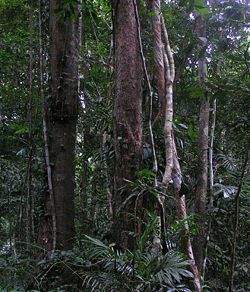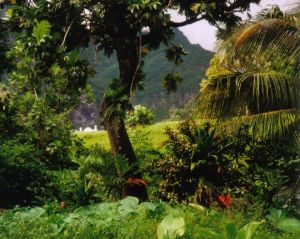Rainforest

A rainforest, is a large, dense forest in a hot, humid region (tropical or subtropical).
Rainforests have an abundance of diverse plant and animal life, much of which is still uncatalogued by the scientific community. There are literally millions of species in the rainforest.
Rainforests once covered about 14% of the Earth but have been reduced in size now to only about 6% of the Earth's surface. Even though half the rainforests of the world are gone, they still hold more than half of all plant and animal species on Earth.
The largest tropical rainforests exist in the Amazon basin (the Amazon Rainforest), in Nicaragua (Los Guatuzos, Bosawás and Indio-Maiz), the southern Yucatan peninsula-El Peten-Belize contiguous area of Central America (including the Calakmul Biosphere Reserve), in much of equatorial Africa from Cameroon to the Democratic Republic of Congo, in much of southeastern Asia from Myanmar to Indonesia and Papua New Guinea, eastern Queensland, Australia and in some parts of the United States. Outside of the tropics, temperate rainforests can be found in British Columbia, southeastern Alaska, western Oregon and Washington, the western Caucasus (Ajaria region of Georgia), parts of the western Balkans, New Zealand, Tasmania, and parts of eastern Australia.
While the Amazon Rainforest is largest in size the Atlantica Rainforest near Rio de Janeiro which has been reduced in size by over 90% it still holds more biodiversity than the Amazon.
While it's commonly believed that rainforests provide much of the oxygen for the planet, and are the "lungs of the world", most rainforests do not in fact provide oxygen for the rest of the world. Through the decomposition of dead plant matter, rainforests consume as much oxygen as they produce, except in certain conditions (primarily swamp forests) where the dead plant matter does not decay, but is preserved underground instead (ultimately to form new coal deposits over enough time). Still, rainforests act as major consumers of atmospheric carbon and may play a large role in cooling air that passes through them. As such, many scientists feel that the rainforests are of vital importance within the global climate system.
Characteristics
Rainforests are characterized by high rainfall, with definitions setting minimum normal annual rainfall between 2 meters (about six 1/2 feet ) The soil can be poor because high rainfall tends to leach out soluble nutrients.
Rainforests are home to two-thirds of all the living animal and plant species on the planet. It has been estimated that many hundreds of millions of new species of plants, insects, and microorganisms are still undiscovered and as yet unnamed by science. Tropical rainforests are called the "jewel of the earth", the "Earth's lungs", and the "world's largest pharmacy" because of the large amount of natural medicines discovered there.
Despite the growth of flora in a rainforest, the actual quality of the soil is quite poor. Rapid bacterial decay prevents the accumulation of humus.
The undergrowth in a rainforest is restricted in many areas by the lack of sunlight at ground level. This makes it possible for people and other animals to walk through the forest. If the leaf canopy is destroyed or thinned for any reason, the ground beneath is soon colonised by a dense tangled growth of vines, shrubs and small trees called jungle.
Trees
There are several common characteristics of tropical trees. Tropical species frequently possess one or more of the following attributes not commonly seen in trees of higher latitudes.
Many species have broad, woody flanges (buttresses) at the base of the trunk. Originally believed to help support the tree, now it is believed that the buttresses channel stem flow and its dissolved nutrients to the roots.
Trees are often well connected in the canopy layer especially by the growth of woody climbers or lianas, plants with epiphytic adaptations, allowing them to grow on top of existing trees in the competition for sunlight.
Other characteristics that distinguish tropical species of trees from those of temperate forests include:
Exceptionally thin bark, often only 1-2 mm thick. Usually very smooth, although sometimes armed with spines or thorns.
Cauliflory, the development of flowers (and hence fruits) directly from the trunk, rather than at the tips of branches.
Large fleshy fruits attract birds, mammals, and even fish as dispersal agents.
The Canopy
Away from river banks, swamps and clearings where dense undergrowth is found, the forest floor is relatively clear of vegetation, as little sunlight penetrates to ground level. The densest areas of biodiversity are found in the forest canopy, a more or less continuous cover of foliage formed by adjacent treetops.
The canopy, by some estimates, is home to 40% of all plant species, suggesting that perhaps half of all life on Earth could be found there. A quarter of all insect species are believed to exist in the rainforest canopy.
Scientists have long suspected the richness of the canopy as a habitat, but have only recently developed practical methods of exploring it. As long ago as 1917, U.S. naturalist William Beebe declared that "another continent of life remains to be discovered, not upon the Earth, but one to two hundred feet above it, extending over thousands of square miles".
True exploration of this habitat only began in the 1980s, when scientists developed methods to reach the canopy, such as firing ropes into the trees using crossbows. Exploration of the canopy is still in its infancy, but other methods include the use of balloons and airships to float above the highest branches and the building of cranes and walkways planted on the forest floor.
Understory
There is a space between the canopy and the forest floor, which is known as the understorey (or understory). This is home to a number of birds, monkeys, snakes, and lizards. The leaves are much larger at this level. Insect life is also abundant.
The rainforest as a source of drugs
Tropical rain forests are called the 'world's largest pharmacy' because of the large amount of natural medicines discovered there. Nearly half of the medicines that humans use come from the rainforests.
Currently 121 prescription drugs sold worldwide come from plant derived sources including 25% of Western pharmaceuticals that are specifically derived from rainforest plants.
The National Cancer Institute has identified 3000 plants that are active against Cancer Cells. 70% of these cancer fighting plants are found in the rainforest.
Today there are over 100 pharmaceutical companies and several government agencies researching plants from the rainforest for possible cures for AIDS, Cancer, and other diseases.
Degradation of the rainforests
It is estimated that we are losing one and half acres of rainforests every second with tragic consequences to both developed and developing nations alike.
Some estimate that as much as 1/2 of the world’s plants, animals, and microorganisms may be lost if the trends of degradation to the rainforest continue unchecked in the next quarter of a century.
Tropical and temperate rainforests have been subjected to heavy logging and agricultural clearance throughout the 20th century, and the area covered by rainforests around the world is rapidly shrinking. It is estimated that the rainforest was reduced by about 58,000 km©˜ annually in the 1990s.
Biologists have estimated that large numbers of species are being driven to extinction, possibly as much as 50,000 a year (or 137 species lost per day) , due to the removal of habitat with destruction of the rainforests.
Protection and regeneration of the rainforests is a key goal of many environmental charities and organizations, including the Rain forest Alliance and the Nature Conservancy.
Rainforest Facts:
Rainforests rarely in temperature go above 93 F and below 68 F. Rainforests cover less than 6 percent of the Earth’s land surface. 70 percent of the plants in the rainforests are trees. About one fourth of all medicines in the world come from rain forests. More than 1, 400 plants in the rain forests are believed to cure cancer. Many trees grow straight for 100 feet then branch out. Over 2,500 types of vines grow in the rain forests. Tropical Rain Forests have very shallow soil with poor nutrients. Animals give nutrients and water is what keep plants alive. Over half of all animals, plants, and microorganisms live in the rainforests.
• A single pond in Brazil can sustain a greater variety of fish than is found in all of Europe's rivers.
• A 25-acre plot of rainforest in Borneo may contain more than 700 species of trees - a number equal to the total tree diversity of North America.
• A single rainforest reserve in Peru is home to more species of birds than are found in the entire United States.
• One single tree in Peru was found to harbor forty-three different species of ants - a total that approximates the entire number of ant species in the British Isles.
• The number of species of fish in the Amazon exceeds the number found in the entire Atlantic Ocean.
• At least 80% of the developed world's diet originated in the tropical rainforest. Its bountiful gifts to the world include fruits like avocados, coconuts, figs, oranges, lemons, grapefruit, bananas, guavas, pineapples, mangos and tomatoes; vegetables including corn, potatoes, rice, winter squash and yams; spices like black pepper, cayenne, chocolate, cinnamon, cloves,ginger, sugar cane, tumeric, coffee and vanilla and nuts including Brazil nuts and cashews.
• At least 3000 fruits are found in the rainforests; of these only 200 are now in use in the Western World. The Indians of the rainforest use over 2,000.
See also
- Cloud forest
- Illegal logging
- Jungle
- Tropical and subtropical moist broadleaf forests
Bibliography
- Richards, P. W. (1996). The tropical rain forest. 2nd ed. Cambridge University Press ISBN 0521421942
- Whitmore, T. C. (1998) An introduction to tropical rain forests. 2nd ed. Oxford University Press. ISBN 0198501471
External links
- Forest Conservation Portal
- Rainforest Live - Facts & Figures
- Save The Rainforest
- Tropical Rainforests
- Rainforest facts and information from The Nature Conservancy
- Rainforest Alliance
- Virtual Rainforest Trip
- CFACT.org (a free-market group that disputes some claims)
- Rainforest people - Pygmies Culture of the African rainforest people, with photos of nature and animals
- Amazon Conservation Team An organization working in partnership with indigenous people in conserving biodiversity, health, and culture in tropical America.
- Save the Amazon Rainforest
- Los Guatuzos, Nicaragua
- Indio-Maiz, Nicaragua
- British Columbia's Rainforests Essays by Elmer G. Wiens.
Credits
New World Encyclopedia writers and editors rewrote and completed the Wikipedia article in accordance with New World Encyclopedia standards. This article abides by terms of the Creative Commons CC-by-sa 3.0 License (CC-by-sa), which may be used and disseminated with proper attribution. Credit is due under the terms of this license that can reference both the New World Encyclopedia contributors and the selfless volunteer contributors of the Wikimedia Foundation. To cite this article click here for a list of acceptable citing formats.The history of earlier contributions by wikipedians is accessible to researchers here:
The history of this article since it was imported to New World Encyclopedia:
Note: Some restrictions may apply to use of individual images which are separately licensed.

